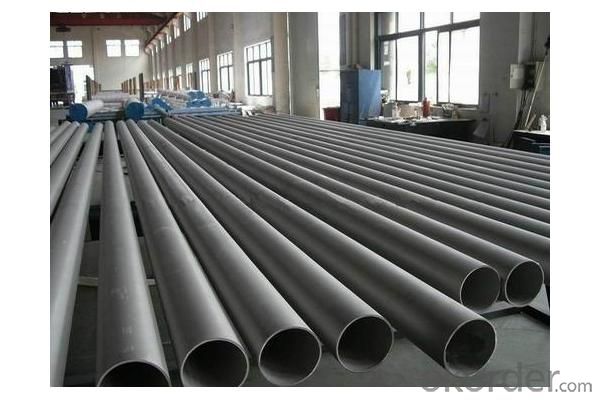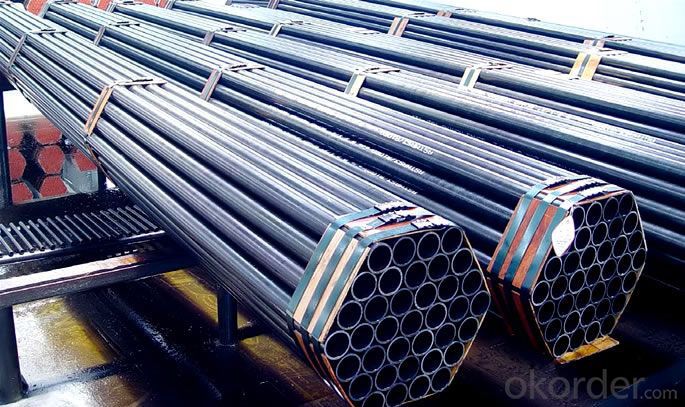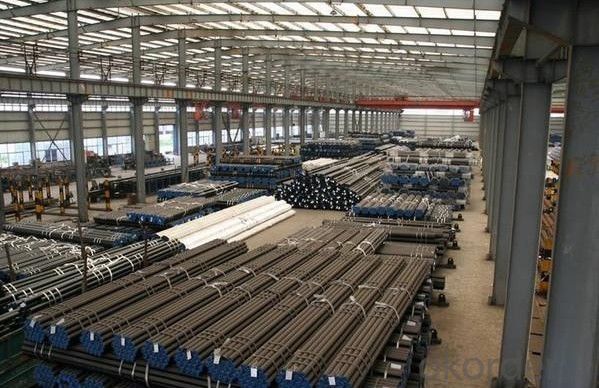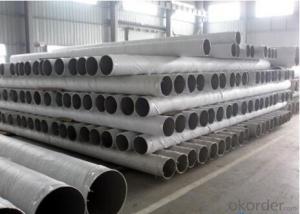Stainless Steel Seamles Pipe 304 ASTM A312
- Loading Port:
- Ningbo
- Payment Terms:
- TT or LC
- Min Order Qty:
- 1 m.t.
- Supply Capability:
- 5000 m.t./month
OKorder Service Pledge
OKorder Financial Service
You Might Also Like
1、Structure of Stainless Steel Seamles Pipe 304 ASTM A312 Description:
Stainless seamless pipe is formed by drawing a solid billet over a piercing rod to create the hollow shell. As the manufacturing process does not include any welding, seamless pipes are perceived to be stronger and more reliable. Historically seamless pipe was regarded as withstanding pressure better than other types, and was often more easily available than welded pipe.
2、Main Features of the Stainless Steel Seamles Pipe 304 ASTM A312:
• High manufacturing accuracy
• High strength
• Small inertia resistance
• Strong heat dissipation ability
• Good visual effect
•Reasonable price
3、Stainless Steel Seamles Pipe 304 ASTM A312 Images:



4、Stainless Steel Seamles Pipe 304 ASTM A312 Specification:
Experienced Lists of Standard |
Applicable Code No. |
Steel Grade |
ASTM |
A213, A269, A312, A789, A790, B677, A268 | TP304/L/H, TP310/S/H, TP316/L/H/Ti, TP317/L, TP321/H, TP347/H, S31803, S32205, S32750, S32304, S31500, TP904L, TP410, TP430, TP405, TP409/409L |
ASME |
SA213, SA312, SA789, SA790, SB677 | TP304/L/H, TP310/S/H, TP316/L/H/Ti, TP317/L, TP321/H, TP347/H, S31803, S32205, S32750, S32304, S31500, TP904L |
JIS |
JIS G3459, JIS G3463 | SUS 304TB, SUS304HTB, SUS304LTB, SUS310TB, SUS310STB, SUS316TB, SUS316LTB, SUS316TiTB, SUS317TB, SUS317LTB, SUS321TB, SUS321HTB, SUS347TB, SUS347HTB |
EN & DIN | EN 10216-5, DIN 17456, DIN 17458 | 1.4301, 1.4307, 1.4541, 1.4878, 1.4401, 1.4404,1.4571,1.4550,1.4438, 1.4436,1.4435, 1.4462, 1.4539, 1.4912, 1.4362 |
GB&GB/T | G B13296 G B/ T14976 | 0Cr18Ni9,00Cr19Ni10,0Cr18Ni10Ti,0Cr18Ni11Nb,0Cr17Ni12Mo2,000Cr17Ni14Mo2,0Cr18 |
Type |
O.D. |
W.T. |
Length | Bending Radius | Application Specification |
S.S Seamless Tubing |
3.17mm – 101.6mm |
0.5mm – 25.4mm |
Max. 22m |
/ | A213, A269, A511, A789; SA213, SA789, B677, SB677; JIS G3463; EN 10216-5 |
S.S. Seamless Pipe |
10.29mm – 355.70mm |
0.89mm – 50.0mm |
Max. 18m |
/ | A312, A790, SA312, SA790, JIS G3459, EN 10216-5 |
S.S. Seamless U-tube |
15.88mm – 76.1mm |
0.89mm – 7.14mm |
Max. 25m |
From 1.5 x OD To 1000mm | A213, A789, SA213, SA789, B677, SB677, JIS G3463, EN 10216-5, SA688 |
Testing:
(1) Hydro-Static Test
(2) Non-Destructive Test
(3) Ultrasonic Test
(4)Eddy-Current Test
5、FAQ of Stainless Steel Seamles Pipe 304 ASTM A312:
①How is the quality of your products?
Our products are manufactured strictly according to national and internaional standard, and we take a test on every pipe before delivered out. If you want see our quality certifications and all kinds of testing report, please just ask us for it.
Guaranteed: If products’ quality don’t accord to discription as we give or the promise before you place order, we promise 100% refund.
②How about price?
Yes, we are factory and be able to give you lowest price below market one, and we have a policy that “ for saving time and absolutely honest business attitude, we quote as lowest as possible for any customer, and discount can be given according to quantity”,if you like bargain and factory price is not low enough as you think, just don’t waste your time.Please trust the quotation we would give you, it is professional one.
③Why should you chose us?
Chose happens because of quality, then price, We can give you both.Additionally, we can also offer professional products inquiry, products knowledge train(for agents), smooth goods delivery, exellent customer solution proposals.Our service formula: good quality+good price+good service=customer’s trust
SGS test is available, customer inspection before shipping is welcome, third party inspection is no problem.
Any question, pls feel free to contact us !
- Q:How about stainless steel 2520 and 316?
- 2520 stainless steel (310S) austenitic chromium nickel stainless steel has good oxidation resistance, corrosion resistance, because of higher content of chromium and nickel content, which has high temperature creep strength, can continuously work under high temperature, good heat resistance. For Ni (Ni), chromium (Cr) content is high, with good oxidation resistance, corrosion resistance, acid and salt, high temperature performance, high temperature resistant steel dedicated to the manufacture of electric furnace tube and so on, increase the amount of carbon austenitic stainless steel, due to the solid solution strengthening effect to the strength improved, chemical composition characteristics of austenitic stainless steel is chrome, nickel based addition of molybdenum and tungsten, niobium and titanium elements, as its face centered cubic structure, and strength and high creep strength at high temperature.
- Q:What is the maximum wall thickness for stainless steel pipes?
- The maximum wall thickness for stainless steel pipes can vary depending on various factors such as the specific grade of stainless steel, the manufacturing process, and the intended application. However, in general, stainless steel pipes typically have a maximum wall thickness of around 40 millimeters.
- Q:Are stainless steel pipes suitable for underground water supply?
- Indeed, stainless steel pipes are a fitting choice for underground water supply. With its exceptional resistance to corrosion and rust, stainless steel proves to be an optimal material for underground usage, where pipes may confront moisture, soil, and other corrosive substances. Notably, stainless steel pipes exhibit durability, longevity, and possess a remarkable tensile strength, enabling them to endure the pressure and strain of underground installations. Furthermore, stainless steel pipes maintain hygiene and do not release detrimental chemicals or pollutants into the water supply. All in all, stainless steel pipes present a dependable and secure alternative for underground water supply systems.
- Q:What is stainless steel pipe made of?
- Stainless steel pipes are made primarily from a corrosion-resistant alloy composed of iron, chromium, and varying amounts of other elements such as nickel, manganese, and molybdenum.
- Q:What is the difference between Type 304L and Type 316L stainless steel pipes?
- Type 304L and Type 316L stainless steel pipes are commonly chosen for a variety of uses due to their ability to resist corrosion. However, they differ in their composition and performance in specific settings. The primary distinction lies in their alloy content. Type 304L stainless steel contains 18-20% chromium and 8-12% nickel, whereas Type 316L stainless steel contains 16-18% chromium, 10-14% nickel, and 2-3% molybdenum. The inclusion of molybdenum in Type 316L enhances its corrosion resistance, particularly in environments with high chloride concentrations. As a result, Type 316L is more suitable for applications where the pipes will come into contact with seawater, brine, or other harsh chemicals. Another factor that sets them apart is their mechanical properties. Type 316L stainless steel has slightly higher tensile strength and yield strength compared to Type 304L. It also exhibits better creep and stress rupture properties, making it more appropriate for high-temperature uses. However, for most general purposes, Type 304L is still a good choice, offering excellent durability and longevity. When it comes to cost, Type 316L stainless steel pipes are typically more expensive than Type 304L due to the additional alloying elements. Therefore, the decision between the two will depend on the specific requirements of the application, taking into account factors such as the corrosive environment, temperature, and budget. Overall, while both Type 304L and Type 316L stainless steel pipes provide excellent corrosion resistance, Type 316L offers superior performance in more aggressive environments and higher temperatures. It is advisable to consult with a materials expert or engineer to determine the most suitable stainless steel pipe for a particular application.
- Q:What are the different surface finishes available for stainless steel pipes?
- There are several different surface finishes available for stainless steel pipes, each with its own unique characteristics and uses. 1. Mill Finish: This is the basic finish that stainless steel pipes come with after manufacturing. It has a dull, rough appearance and is suitable for applications where aesthetics are not a major concern. 2. Brushed Finish: Also known as satin finish, this surface finish is achieved by brushing the stainless steel pipe with abrasive material. It creates a smooth, brushed appearance with fine lines running in one direction. Brushed finish is commonly used in architectural applications and can provide a more polished look compared to the mill finish. 3. Mirror Finish: This is the most reflective surface finish available for stainless steel pipes. It is achieved by polishing the surface to a high gloss using progressively finer abrasives. Mirror finish is commonly used in decorative applications and provides a sleek, reflective appearance. 4. Polished Finish: This finish falls between the brushed and mirror finishes. It is achieved by polishing the surface to a smooth, shiny appearance using finer abrasives than the brushed finish. Polished finish is often used in applications where a more refined, but not overly reflective, look is desired. 5. Bead Blasted Finish: This finish is achieved by blasting small glass beads against the surface of the stainless steel pipe, creating a uniform matte appearance. Bead blasted finish is commonly used in industrial applications where a non-reflective surface is required, such as in food processing or pharmaceutical industries. 6. Electropolished Finish: This is a specialized surface finish that involves electrochemical polishing of the stainless steel pipe. It removes surface imperfections, enhances corrosion resistance, and creates a smooth, bright appearance. Electropolished finish is commonly used in industries that require high sanitary standards, such as pharmaceutical and biotechnology. These are just a few of the different surface finishes available for stainless steel pipes. The choice of finish depends on the specific application requirements, such as aesthetics, corrosion resistance, and cleanliness.
- Q:How do you determine the size of a stainless steel pipe?
- The size of a stainless steel pipe is determined by measuring its outer diameter using a caliper or a tape measure.
- Q:How do you prevent vibration in stainless steel pipes?
- There are several measures that can be taken to prevent vibration in stainless steel pipes. 1. Use proper pipe supports: The selection and installation of appropriate pipe supports are crucial in preventing vibration. Ensure that the supports are designed to provide adequate stability and rigidity to the pipe system. This will help to minimize any potential movement or vibration. 2. Dampen vibrations with isolators: Install vibration isolators at strategic points along the pipe system. These isolators are designed to absorb and dampen vibrations, thereby reducing the transmission of vibrations through the stainless steel pipes. 3. Proper pipe alignment: Ensure that the pipes are properly aligned during installation. Misalignment can lead to stress concentrations and increased vibration. Proper alignment will help to distribute the forces evenly and reduce vibration. 4. Reduce fluid velocity: High fluid velocities can cause turbulence and induce vibrations in the pipe system. By reducing the fluid velocity through the pipes, you can minimize the occurrence of vibrations. This can be achieved by adjusting the flow rate or by using flow control devices such as throttling valves. 5. Soundproofing measures: In some cases, vibrations can be caused by external factors such as nearby machinery or equipment. Implement soundproofing measures to reduce the noise and vibrations generated by these sources. This can include using noise-absorbing materials or installing barriers to block or redirect the vibrations. 6. Regular maintenance and inspection: Regularly inspect the pipe system for any signs of vibration or wear. Address any issues promptly to prevent further vibration problems. Additionally, ensure that the pipe system is properly maintained, including regular cleaning and lubrication of any moving parts. By implementing these measures, you can effectively prevent vibration in stainless steel pipes, ensuring the overall stability and integrity of the pipe system.
- Q:What are the common sizes and dimensions of stainless steel pipes?
- There are various common sizes and dimensions of stainless steel pipes available, ranging from small diameters of 1/8 inch to large diameters of 36 inches or more. The wall thicknesses can vary depending on the application, but commonly range from Schedule 5S (thin) to Schedule 160 (thick). The lengths of stainless steel pipes are typically standardized at 20 feet.
- Q:Can stainless steel pipes be used for breweries?
- Yes, stainless steel pipes are commonly used in breweries. Stainless steel is the preferred material for brewing equipment and piping systems due to its excellent corrosion resistance, durability, and hygienic properties. Stainless steel pipes can withstand the harsh and acidic conditions present in breweries, such as high temperatures, alkaline and acidic cleaning agents, and exposure to various chemicals. Additionally, stainless steel pipes are easy to clean and maintain, ensuring that the beer produced remains uncontaminated and of high quality. Overall, the use of stainless steel pipes in breweries helps to ensure a safe and efficient brewing process.
1. Manufacturer Overview |
|
|---|---|
| Location | |
| Year Established | |
| Annual Output Value | |
| Main Markets | |
| Company Certifications | |
2. Manufacturer Certificates |
|
|---|---|
| a) Certification Name | |
| Range | |
| Reference | |
| Validity Period | |
3. Manufacturer Capability |
|
|---|---|
| a)Trade Capacity | |
| Nearest Port | |
| Export Percentage | |
| No.of Employees in Trade Department | |
| Language Spoken: | |
| b)Factory Information | |
| Factory Size: | |
| No. of Production Lines | |
| Contract Manufacturing | |
| Product Price Range | |
Send your message to us
Stainless Steel Seamles Pipe 304 ASTM A312
- Loading Port:
- Ningbo
- Payment Terms:
- TT or LC
- Min Order Qty:
- 1 m.t.
- Supply Capability:
- 5000 m.t./month
OKorder Service Pledge
OKorder Financial Service
Similar products
New products
Hot products
Hot Searches
Related keywords





























